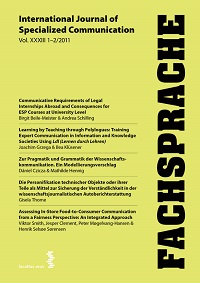Die Personifikation technischer Objekte oder ihrer Teile als Mittel zur Sicherung der Verständlichkeit in der wissenschaftsjournalistischen Autoberichterstattung
##plugins.themes.bootstrap3.article.main##
##plugins.themes.bootstrap3.article.sidebar##
Abstract
Consciously focusing on the subject of the text by personifying it or its constituent parts is an especially impressive means of making technical facts accessible to professional lay people. In applying this technique, authors of scientific-journalistic reporting on private cars are guided by current findings in comprehensibility research. According to this approach, understanding is the result of complex social and mental processes occurring between participants in communication in which new information contained in the text combines with the knowledge stored cognitively within the individual. Thus, consistently attributing human qualities to cars of different types, as a form of latently effective metaphor, prompts readers to establish analogies between the properties of the car in question and the personal qualities and experience they are familiar with, rendering in this way the behaviour, appearance and functioning of technical objects more understandable. This knowledge can be applied to designing e.g. attractive German advertising texts and translating into German, in an idiomatic manner, in order to reflect that language’s special preference for the presentation of personified technical and other inanimate elements.
Zitationsvorschlag
##plugins.themes.bootstrap3.article.details##
scientific journalism, comprehensibility of texts, text understanding, cognitive science, cognitive linguistics, instructional psychology, information processing, language processing, text patterns, semantic structures, phraseology, metaphor

